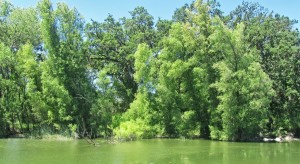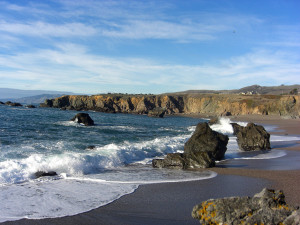In the first few months after California announced its park closures in May 2011, park advocates were stunned and outraged. The state was tearing down 25 percent of a world-renowned system70 parks in all. Almost a year later, the state parks closure cloud still looms, big and black. But dozens of small victories and individual acts of courage are adding a silver lining.
The good news started with some wins last year. A handful of beach lovers and staff at McGrath State Beach near Ventura raised half a million dollars for the new sewage system that is keeping that park open. And a nonprofit, the Coe Park Preservation Fund, raised more than a million dollars to protect its namesake park near San Jose.
Institutional neighbors stepped up, too. The National Park Service has pledged to keep Tomales Bay, Samuel P. Taylor, and Del Norte Coast Redwoods state parks open for at least a year. Counties and cities have offered to provide services at parks within their borders.
“People are beginning to be mobilized in a way they haven’t before,” said California State Parks Foundation president Elizabeth Goldstein.
At the same time, promising and dedicated grassroots leaders have emerged. To name a few: Greg Hayes, a former state park superintendent, has forsaken retirement to try to rescue Jack London Historic State Park; Kathy Bailey, a longtime resident of Northern California’s Anderson Valley, is devoting her days to working with her neighbors to keep Hendy Woods State Park open; Robert Hanna, not long ago a sales manager in a financial firm, has teamed up with activists at several state parks to “do everything I can to help keep parks open.” Perhaps Hanna was destined to be a leader; he is John Muir’s 31-year-old great-great grandson. Somehow this crisis has led him and dozens of other Californians to a new calling: preserving state parks.
Inside and outside the bureaucracy, the crisis has highlighted some not-so-new ideas. At Samuel P. Taylor State Park, in Marin, supervising ranger Rose Blackburn is reassessing her use of volunteer campground hosts. In exchange for free RV space, they work 20 hours a week helping park visitors and handling emergencies. In peak season, she now has two campground hosts and may expand that to three or four, with one host concentrating on maintenance. One surefire revenue enhancement at Taylor is a new lodging option: five new primitive cabins that she hopes will be ready for visitors this summer, at $100 a night or so (compared with $35 for a campsite).
In the past, some parks neglected collecting fees, partly because the revenue went to Sacramento to be shared among all the parks. Now new models are being explored. At Mono Lake Tufa State Natural Reserve, for example, the nonprofit Bodie Foundation will collect a $3 parking fee to be invested right back into Mono.
Save the Redwoods League’s executive director Ruskin Hartley said basic entry fees to state parks should be kept low to ensure people can afford to visit, “but that doesn’t mean you should pay the same amount to camp on July 4th as you would on January 4th.”
In Sonoma, the county parks department and the nonprofit organization LandPaths hope to build support by reintroducing parks to local communities in places like Annadel State Park.
“We’d start by bringing out kids from every single school in Santa Rosa within walking distance,” said LandPaths’ executive director Craig Anderson . “We’d see if senior communities could have picnics at the trailhead. We’d see if we could entice the 30-somethings with something kind of edgy and fresh.”
The Napa County parks department has suggested pooling government resources to run parks more efficiently. For example, the county sheriff might set up a substation on state park land in exchange for keeping an eye on Bothe-Napa State Park. Cities and counties have also offered to help with trash pickup and other services on state park lands near facilities they already manage.
The state Legislative Analyst’s Office (LAO) also had efficiency in mind when it challenged a rule requiring all state park rangers to have peace-officer (police) training. As a March 2012 LAO report states, “While some ranger duties, such as responding to emergencies and making arrests, require peace officer status, many of them do not (such as managing staff, providing information to visitors, and leading school groups on tours).” Reducing the number of peace officers could reduce state parks’ expenses by at least a few million dollars, the report said.
A few additional millions could be garnered by the passage of the California State Parks Stewardship Act of 2012, A.B. 1589. Introduced by Jared Huffman (D-San Rafael) in February, the bill would allow residents to buy an annual state park pass when filing tax returns, and introduces a special state park license plate. It also sets up a fund that would pool $25 million in unused bond money to pay for the installation of revenue and fee collection equipment and technologies to increase park visitation and revenues, among other measures. The bill passed out of its first committee unanimously last week.
This is just a small sampling of the promising ideas that have emerged in the past few months. They are not enough to counter the problems that will arise from the state’s meat-ax approach to budget cutting. Dozens of parks are expected to close on July 1, and they will be damagedperhaps permanently. The jury is still out on whether closures will actually save money.
But the shock of closures has also had its benefits, moving California toward more government cooperation, energized nonprofit leadership, and generous private contributions of time and money. The parks idea of the early 20th century is being updated for the 21st century with broad, sometimes angry, but decidedly engaged public participation. People are joining their neighbors. They’re reconnecting with their parks.

.jpg)




